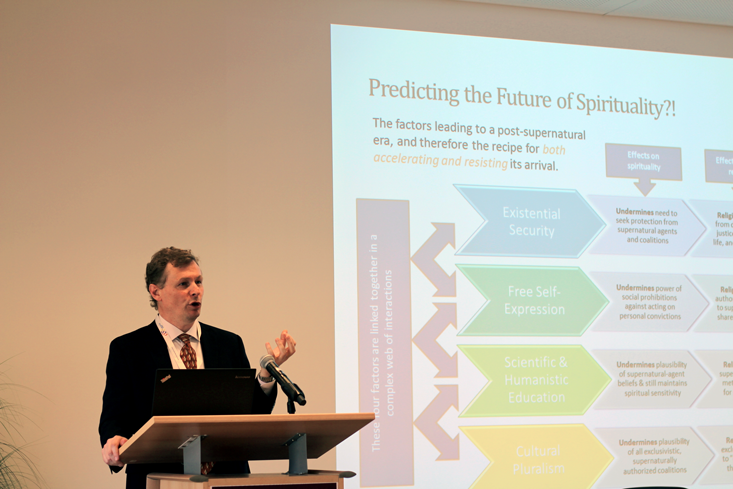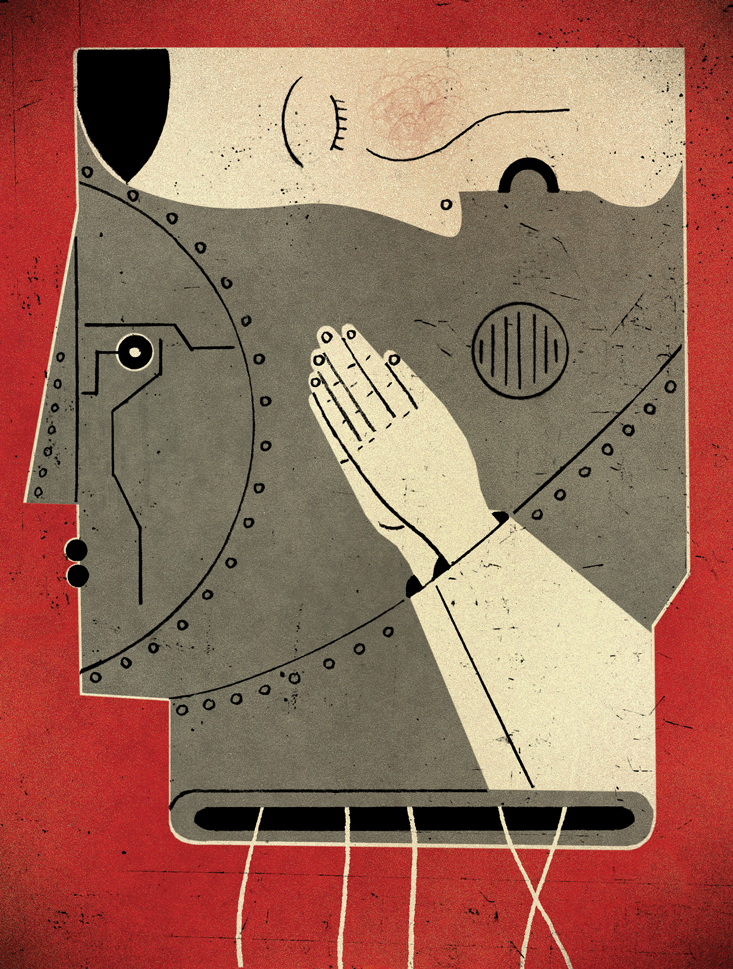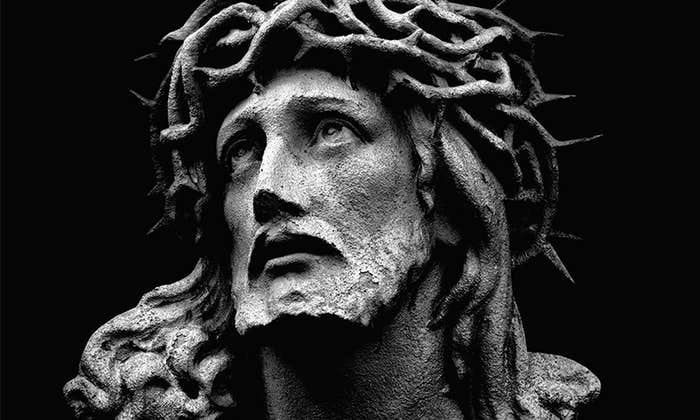In the United States, the nones have it. The nones being people with no organized religion and increasingly no belief in God or a universal spiritual power. They have the momentum, attention, and an expectation that in the future they will become a majority of the population, just as they currently are in western Europe, Japan, and China.
Or so says the Pew Research Religious Landscape Study, which in 2015 found that almost a quarter of Americans profess no religious affiliation. Within that group, a third do not believe in God or a higher power of any sort (“nothing in particular,” as the study termed it). Both numbers are up from a similar study in 2007, when 16 percent of the country professed no religious affiliation, and 22 percent of these did not believe in God. Driving the growth are Millennials, those born between 1980 and 2000. As they come of age, 70 percent of them say they do not believe in a higher power.

Pew expects the percent of religious Americans will continue to fall. It suggests older generations will die off and take their belief with them. Outside the U.S., a WIN/Gallup International poll found that more than half of Vietnamese, Koreans, and French people say they are atheists or not affiliated with a religion. For the Japanese and Germans, it’s more than 60 percent, and for the Dutch and British, two-thirds. Certainly, belief in nothing has market momentum.
The rise of the nones presents a compelling backdrop to the Modeling Religion Project, led by Boston University philosopher and theologian Wesley Wildman, and his counterpart at Norway’s University of Agder, LeRon Shults. The project, begun in 2015, is unique in the breadth of its effort to simulate religious trends. It’s based on computer models that incorporate anthropological, archeological, psychological, and modern demographic data related to religion. Its goal is to draw conclusions about how and why religions have formed through history, what impact they have on individual and group behavior, and how they might develop in the future. Given the ascent of non-believers in the recent past, what might the Modern Religion Project say about the future of atheism? Will we one day live in a world of nones?
The Modeling Religion Project got its start when Wildman started asking whether he could replicate proto-civilizations to see for himself why religion seems to emerge. Theories have abounded for ages. Plato’s philosopher-kings saw religion as a political tool, as did the proletarian Karl Marx. Max Weber thought Protestantism was better for economic growth than Catholicism. Sociologist Rodney Stark has theorized Christian practices such as a willingness to care for the sick are what caused Christianity to outstrip the Roman pantheon. Evolutionary biologists debate whether religion is adaptive, a useful evolutionary tool, or a byproduct of our over-large brains. Stephen Jay Gould dubbed byproducts that become useful “spandrels,” after the curved spaces on arch supports that don’t have a structural purpose but are often given beautiful decorations. Religion was a spandrel of consciousness, he argued—consciousness being essential for survival, but also leading to an awareness of mortality, then succor through religion, not essential to survival.
Certainly, belief in nothing has market momentum.
In 2012, Wildman and Shults were at a conference of the Çatalhöyük Research Project in Çatalhöyük, Turkey, the biggest Neolithic archaeological site yet found, and a source of intense interest for what it tells us about early human culture, including religion. They sat around their hotel for a week arguing about what things they’d need to include for a model that could test the role religion played in Çatalhöyük’s development. They debated whether models could test various theories about religion. Shults says the two wanted to see what it would take for a group of humans in early hunter-gatherer groups to become townspeople. Research in cognitive psychology over the last decade had marked different aspects of human interaction on moral, social, and ritual biases. They thought there was now the chance to model a system and see how social cohesion emerged.
Wildman knew he could develop crude models, but he wanted to get access to better computers than exist in the Boston University School of Theology (where all the good PCs have gone to heaven). He and Shults connected with the Virginia Modeling and Simulation Center, or VMASC, at Old Dominion University. It typically works on models for use in maritime research and alternative energy, fields with complex interactions.
The idea of trying to model the impact of something as complex as religion in civilization was interesting to Saikou Y. Diallo, research associate professor at VMASC, in part because of the challenge of coming up with ways to model things that are qualitative, like emotions or beliefs. “Obviously, feeling emotion and such cannot be simulated, so we’re not going to attempt to do feelings and emotions,” Diallo says. “We’re going to model theories about why people feel the way they feel, look for explanations of why those feelings occur, not those feelings themselves.”
Diallo says the technical challenge is knowing how to turn the aspects of emotions into algorithms. Algorithms are, in essence, recipes. Building a recipe for how the emotion gets expressed in society was the challenge in building what became the “Neolithic transition model,” first of several models that look at how civilizations transform. “If I told you to stir in a little bit of love, how do you do that?” Diallo asks.
What they could do is model the expression of feelings, sentiments, and what factors into them. Perhaps what causes social bonds is having enough food, enough festivals, the opportunity to have more choices for mates, some ability to have a home and to be protected from raiders. Perhaps it also comes from having a purpose beyond mere survival. They might not directly model supernatural belief, but they could create a variable that shows how people and groups react to figures with outlier levels of charisma or influence. Degrees of belief can increase or decrease group participation.
They developed the Neolithic transition model for 15 to 20 different possible settings of an early post-hunter gatherer Neolithic community a la Çatalhöyük. The settings included things like birth rates, number of required rituals, available technology (i.e., domesticated animals), punishment levels—each based on what archaeology has to say about how society was structured, drawing on public spaces, large buildings, and types of dwellings. The models are designed in a way that resembles a hybrid of a flow chart and a Venn diagram. Overlapping big and small circles represent things like time spent in ritual practice, willingness to give up freedoms for safety, and other kinds of social interaction. Graphs show how a society grows based on the interaction of these factors.
With the first models, Wildman says, they wanted to test a theory of whether the emergence of early culture meant a commitment to cultural goals, and a social bond among people, two distinct forms of cooperation. Could these commitments emerge without religion?
Getting beyond the supernatural state requires a bounty of resources.
The models began running, 120 simulations at a time, on VMASC’s systems, creating data about different scenarios involving how early human proto-societies like Çatalhöyük might have developed. The main theory being tested was the Big Gods hypothesis put forth by Ara Norenzayan, a University of British Columbia evolutionary psychologist, who argues that moralizing, powerful deities go hand in hand with market-based farming societies. Without deities that transcend clan bonds, it’s hard to get people to cooperate with those from other groups.

The VMASC computers ran the model hundreds of thousands of times with different variables for the various parameters. What typically happened was at a certain point in each simulated society, the town would either coalesce or fail. Those that succeeded almost always had reached the point where religious symbols and behaviors were competing with kin as the driver of social identity and cooperation. Religious beliefs about supernatural monitoring, probably by an all-seeing god or gods with the power to punish, and rituals that connect people with their god or gods, magnified cooperation. “In our model, the agricultural transition doesn’t happen without religion, or at least is a LOT more difficult and a LOT more chancy,” Wildman wrote in an email. With religion, the transition “is more likely to happen.”
The models included a percentage of what Wildman calls “high intensity” people, individuals with charisma who could potentially create religious movements (and would definitely not be counting sheep and goats to ensure there was enough to eat). The models show that religion and the number of high-intensity individuals tend to increase together. Further, the emergence of high intensity people and religious rituals “seem to ratchet up the social intensity that gives a community its character,” Wildman says.
Religion doesn’t create the shift from Abel to Cain, from nomadic shepherd to town-centered farmer. But it smooths out the transition, Wildman says. It makes early towns more likely to succeed. In part, that’s because religion demands unorthodox behaviors, rituals, appearing at worship services. These show who is willing to participate and who is not, which might help eliminate what economists call the free-rider problem, people who take the benefits of society without contributing to it. Those who won’t perform the rituals can be cast out, or shunned. Meanwhile, shared beliefs soften what Wildman calls “the hatred of being watched by strangers.” Religion mattered in how communities formed, Wildman says. We often think of religion as divisive, forgetting it plays an important role in bringing different people together.
So what can the Modeling Religion Project tell us about societies without religion? Wildman explains the computer models for the most part do not apply to specific moments in time—no looking at atheism in the French Revolution or the rise of free-thinkers in various parts of Europe just after 1600. The finished models for the project apply primarily to periods in history where significant religious change occurs, including the Axial Age (the period between the eighth and third centuries B.C., when important religious developments like monotheism emerged) and the post-Enlightenment era, when education and social tolerance for new ideas begin to emerge.
One of the computer models, dubbed the Modernity model, shows the emergence, roughly in the 1700s, of societies losing their religion, in the sense that noticeable numbers of people begin to contest intuitive, teleological beliefs ascribing events to some higher cause or meaning. Those include Spinoza challenging the idea of divine providence, or Hobbes the existence of the supernatural. Such challenges can remain part of a supernatural society or over time lead to what Wildman calls a “post-supernatural” society.
To get beyond the supernatural state requires a combination of factors. Resources like food and energy must be plentiful through most or all levels of society. That eliminates the need for people to ask supernatural agents to help them. Societies have to be pluralistic and value diversity, with diverse opinions that show how people with differing religious beliefs share similar structures of thought. Education has to be scientific and humanistic, and widespread. And people must have freedom to exhibit non-religious behavior and beliefs without punishment, like loss of status.
There is an earlier period of history where these conditions exist, in Rome around the second century A.D. In his 2015 history of atheism in ancient Greece and Rome, Battling the Gods: Atheism in the Ancient World, British scholar Timothy Whitmarsh, who specializes in Greek culture in the Roman empire, writes that pluralistic Romans allowed both religious beliefs and atheism to coexist. He says atheism in the Roman Empire existed “as a kind of virtual network,” linked together by texts that promoted the idea of a shared heritage in classical Athens. “Atheism was a well understood phenomenon in the early Roman Empire,” he says.
Powerful deities go hand in hand with market-based farming societies.
Whitmarsh is not directly familiar with the Modeling Religion Project. When it is described to him, he questions whether the models could control for a community that would form bonds without religion. He agrees that levels of belief fluctuate across cultures, but is skeptical of graphing those levels accurately because historians, for long periods of human history, can only rely on “the dominant, official view of things,” and not evidence from countercultures. Also, the archaeological and historical records don’t tell us what we’d like to know about ancient levels of religious belief. “It’s hard to put a number on it,” says Whitmarsh. “Ironically,” he adds, “we don’t have censuses and surveys” even for the Greeks, whose society was admired enough by later societies that we have a remarkably well-preserved record of their thinking.
Wildman says atheism and non-religious communities have taken root in societies for significant periods. But he hastens to add that his models show religious belief returns when it wanes. Belief in Zarathustra or Zeus might wither, even be replaced by nothing. But people will still be inclined toward some kind of supernatural belief. These will eventually lead to ritual practices and other religious structure, and then a new religion emerges.
In this way, the Modeling Religion Project reflects traditional theology. That religious intensity might rise in time of crisis is something seen in the Hebrew Bible, notes Francis X. Clooney, Director of the Center for the Study of World Religions and professor at Harvard Divinity School. “The people fall away from the Lord in times of prosperity, but return in times of need,” he wrote in an email. “And texts like the Bhagavad Gita see the divine intervention in the world as occurring most often in times of crisis.” Social theorists of religion like Stark, Pippa Norris, and Ronald Inglehart have all developed theories (models that don’t rely on computers) suggesting that people rely on religion less for comfort when they feel comfortable in the world.

Of course, history has seen atheistic societies, at least since the start of the French Revolution in 1789, and later the socialist republics of Eastern Europe, communist China, Vietnam, Cuba. Today’s thoroughly secular (though not majority atheist) nations of Western Europe, notably in Scandinavia, also seem to fit the part of Norenzayan’s Big Gods theory that holds strong state institutions and rule of law can replace the need for an all-seeing God to keep people in line.
But Wildman’s models suggest religion could even return to societies like these, though for Scandinavia it would probably take a culture shock, like climate change disrupting the food supply or war inhibiting pluralism. Religious practice in China has grown from as low as 100 million people during the 1960s, at the height of the Cultural Revolution, to by some estimates more than 700 million people today. Russia, post-Soviet Union, has seen atheists fall from about 40 percent of the population to 15 percent today.
Heeding such world religious and social trends, the 2015 Pew Research Religious Landscape Study forecasts that nones, despite their current rise in the U.S. and France, will shrink as a percentage of the world’s population between now and 2050, as religion continues to spread through the developing world, and the developed world’s share of world population shrinks. Likewise, the Modeling Religion Project’s simulations point toward the ongoing widespread existence of supernatural beliefs, which could accelerate in the face of ecological disaster, such as drought-driven massive crop failure, where people cannot feel self-reliant.
The Modeling Religion Project continues to refine its models and build new ones. One of its recent models looks at how religion and violent behavior interact. And the team is currently working on a Holy Grail of sorts, LuCy, short for “lucid cybernetic agent,” and a nod to the hominid fossil that is over 3 million years old, to plumb deeper into the origin of religion.
So far, Wildman says, the project has shown that both supernatural and non-supernatural societies can and do occur, depending, of course, on the variables. When he looks past the project, though, Wildman sees the perennial emergence of supernatural ones. People have a basic propensity—a biological imperative—toward a desire to ascribe actions to an agent, a being, even one we cannot see, Wildman says. “Every generation is born supernaturalists.”
Michael Fitzgerald is an award-winning journalist in Cambridge, Massachusetts. He is articles editor at The Boston Globe Magazine.






























